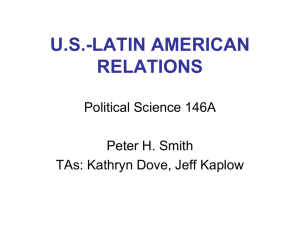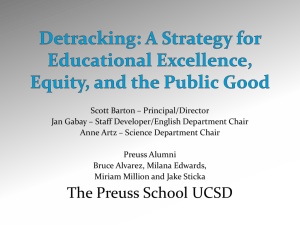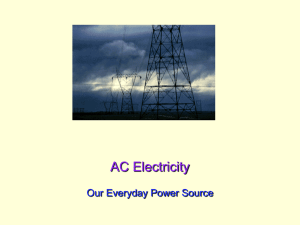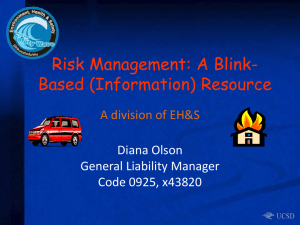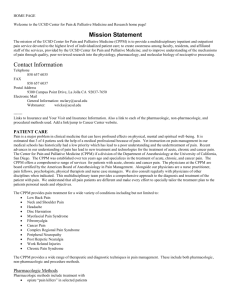PowerPoint Lecture - UCSD Department of Physics
advertisement
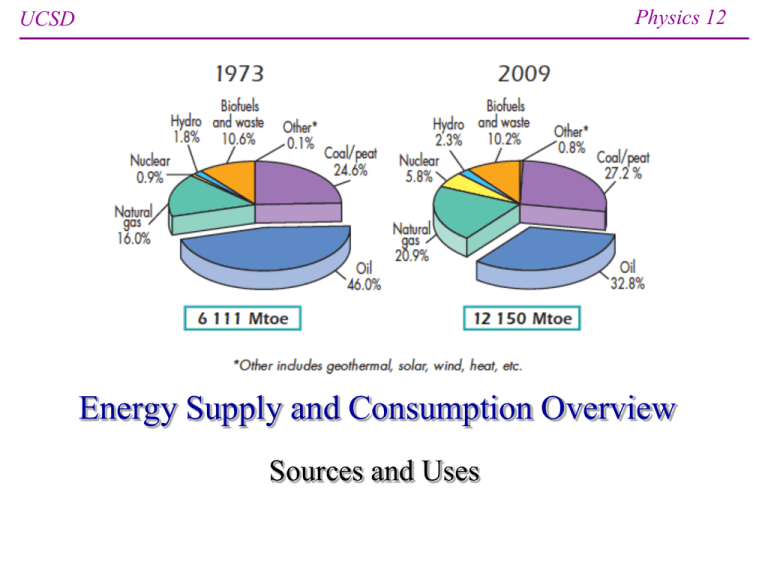
Physics 12 UCSD Energy Supply and Consumption Overview Sources and Uses Physics 12 UCSD The Global Energy Scene • Global energy production is about 480 QBtu/yr – a QBtu is a quadrillion Btu, or 1015 Btu – so about 51020 J per year (1 Btu is 1055 J) • U.S. share is about one fifth of this (1020 J) – 1996 value in book (1st edition) is 93 QBtu/year – 2003 value in second edition is 98.3 QBtu/year – 2011 number from E.I.A. is 97.3 Qbtu/year (recession) • 1020 J/yr = 31012 W – divided by 300 million people (3108) = 104 W per person (10 kW) Spring 2013 2 Physics 12 UCSD Reminder: how do we stack up? world average = 10 bbl/yr Spring 2013 3 UCSD Physics 12 • More Countries • Logarithmic scale • Fills in the gaps • 1971 data Spring 2013 4 UCSD Physics 12 The Fall of the Work Animal • Used to rely completely on animals for transportation • Trains entered the picture in the mid-1800s • Cars entered the scene in a big way around 1920 • World has never been the same • Work animal fell off the map around 1940 • Today automotive is over 95% of the story Spring 2013 5 Global Amounts and trends UCSD Physics 12 • Doubled energy use in 36 years: 2% growth – Mtoe is million tons oil equivalent: 1 toe is 39.7 MBtu • Fraction in fossil fuels went from 87% to 81% – still a fossil-dominated world: renewables are tiny Spring 2013 graphic from IEA: Key World Energy Statistics 6 UCSD Evolution of Energy Sources Physics 12 2.7% growth line in red Spring 2013 7 Physics 12 UCSD U.S. Consumption in 2003 Source Amount QBtu Percent 1018 Joules Coal 1.08109 tons 22.6 23% 23.8 Natural Gas 21.81012 ft3 22.5 22.9% 23.7 Petroleum 6.72109 bbl 39.1 39.8% 41.3 Nuclear 757109 kWh 7.97 8.1% 8.4 Renewables 578109 kWh 6.15 6.3% 6.5 98.3 100% 103.7 Total Spring 2013 8 Physics 12 UCSD U.S. Consumption in 2011 Source Amount QBtu Percent 1018 Joules Coal 1.09109 tons 22.2 23.0% 23.4 Natural Gas 23.51012 ft3 23.5 24.3% 24.8 Petroleum 5.9109 bbl 33.5 34.6% 35.3 Nuclear 790109 kWh 8.26 8.5% 8.7 Renewables eclectic mix 9.24 9.6% 9.7 96.7 100% 101.9 Total Spring 2013 9 UCSD From Energy Information Agency Annual Energy Review, 2011 Physics 12 compare to Figure 1.5 in book (2003 numbers) Spring 2013 10 Physics 12 UCSD (U.S.) • • • • Hydroelectric pretty tapped out Biofuels and wind ascending, now at ~2% and 1%, resp. “Other” contains geothermal, solar, and waste reprocessing Dominant renewables are old technology Spring 2013 11 UCSD U.S. Consumption vs. Production Physics 12 policy change Spring 2013 12 UCSD Physics 12 Where is our energy produced, and of what flavor? based on 2003 data Spring 2013 13 UCSD Energy By Source and Sector, 2011 Physics 12 Spring 2013 14 source EIA AER 2011, Section 2 Physics 12 UCSD Interpreting the Spider Web • The stacks themselves are straightforward – the left-hand stack you’ve already seen in other forms • The connecting lines indicate % use of each branch – for instance, 93% of transportation comes from petroleum, 3% from natural gas, 4% from renewables – meanwhile, 71% of energy from petroleum goes to transportation, 23% in industry, 5% directly in homes, 1% for electricity • Nuclear is all for electricity, and coal mostly so – almost half of electricity comes from coal • Petroleum is primarily for transportation • Natural gas is the most versatile, followed by renewables Spring 2013 15 Physics 12 UCSD Lessons • Our energy production is completely dominated by fossil fuels: 81% – nuclear and hydroelectric make up much of the balance • Part of our enormous appetite is due to the expanse of our country: transportation is important • Space heating is also an issue in a country where detached houses are the rule • Any industrial society (at our current scale) is going to have a large demand for energy Spring 2013 16 Physics 12 UCSD References & Assignments • Energy Information Agency Annual Energy Review – http://www.eia.gov/totalenergy/data/annual/index.cfm • International Energy Agency Key World Energy Statistics – http://www.iea.org/publications/freepublications/publication/name, 31287,en.html • A recent amazing book: – Sustainable Energy—without the hot air, by David MacKay – www.withouthotair.com (get book for free!) – see 10-page synopsis for quick-read/intro • Another worthy book: ENERGY: A Guidebook, by Janet Ramage (more global perspective) • Assignments – Quiz #1 ready on TED, due by 11:59 PM tonight – Read Chapter 2 – Homework #2 to be found on the web: get an early start! Spring 2013 17

